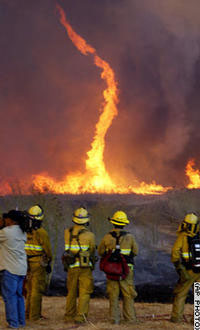Southern California still enveloped in flames
Thousands of houses in Southern California are destroyed by the wildfires that have been burning in the state for more than a week.

Speaking at a town hall meeting Monday night, he asked what officials could do to ensure better warning systems are put in place.
"After the Cedar Fire in 2003, we thought lightning wouldn't strike twice," Graham said at the community forum, referring to the devastating infernos that ravaged many of the same areas of San Diego County four years ago. "But it could be that lightning could strike a third time."
County officials last week made more than 300,000 emergency calls, known as reverse 911 calls, telling residents flames were approaching and to leave their homes.
But some of the 100 or so displaced residents at the meeting said they received no such warnings.
Khosrow Motamedi angrily confronted San Diego Mayor Jerry Sanders, telling him he only survived because his neighbors woke him up in the early hours of Oct. 22.
"Would it not have been a problem to do a reverse 911 call? To sound sirens in the street?" Motamedi asked.
"There were sirens all over the city," Sanders responded from the podium, prompting objections from the audience.
So far, the wildfires have destroyed more than 2,000 homes, and they continued to burn Tuesday.
Firefighters had surrounded more than a dozen blazes, and worked to gain control of five others that were at least half contained. The flames have killed 14 people and blackened 809 square miles (2,095 square kilometers) from the Mexican border to Los Angeles.
In the weeks ahead, hundreds of families who lost their homes will be at the mercy of the federal government for grants, loans and other assistance.
Some help can be offered quickly, but larger decisions about the future will take weeks, and be decided by federal workers shuffling mountains of loan applications in Fort Worth, Texas, and suburban Maryland.
Typically, only property owners are eligible for the Federal Emergency Management Agency's maximum US$28,200 (€19,600) payout for lost homes. But FEMA spokesman Michael Raphael said the agency looks at each loss on a case-by-case basis.
FEMA has already received nearly 8,300 applications for aid and visited 641 homes to assess damage in the seven counties declared a major federal disaster area. As of Monday, the agency had paid out US$600,000 (€417,000), and was on pace to settle about 75 claims a day.
Fire victims have said FEMA apparently learned from the confusion after Hurricane Katrina about where residents should turn for help.
The agency has sent scores of neatly dressed agency representatives to the San Diego area. Large signs and tents bearing the agency's name direct victims to one-stop centers where victims can redirect their mail, apply for building permits and register for federal disaster assistance.
But the scale of the disaster here is much smaller than in New Orleans, where hundreds of thousands of people were left homeless.
One challenge for residents is proving what their home was worth and how much was lost, especially if important paperwork went up in flames.
Robert Sanders, 56, a commercial photographer who lost his Rancho Bernardo house, complained Monday about the pile of documents he had to fill out for assistance. The information requested had gone up in smoke.
"Everything you have has been ripped from your soul, filling out these forms is the last thing you want to do," Sanders said. "What you want to do is just climb on the back of a Harley and go ride and live out of pup tent for the rest of your life. It's a real sense of futility."
Subscribe to Pravda.Ru Telegram channel, Facebook, RSS!


